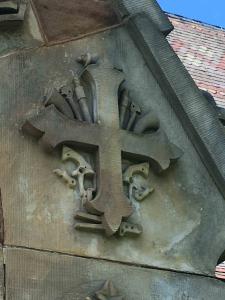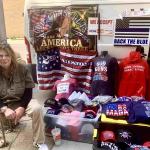This month at the Anxious Bench, a number of columnists are participating in a joint collaboration with the AACC (Asian American Christian Collaborative) to draw attention to the mournful history of gun violence in the United States. This post is part of this effort.
Last week I toured a church whose doorways were graced with crosses flanked by revolvers and whose pillars featured sculpted pistols.
You might think that a church that so flagrantly blended the cross with the gun was an evangelical meeting place located in a deep-red state, but actually, it was an Episcopal church located in Hartford, Connecticut, a center of some of the nation’s strongest advocacy for restrictive gun laws.
A hundred and sixty years ago, when the Church of the Good Shepherd was built, the prevailing attitudes toward guns in central Connecticut were very different. The Connecticut river valley was the gun manufacturing capital of the nation – the manufacturing center for Smith & Wesson and Winchester rifles, as well as several other arms manufacturers that are no longer household names. It was Connecticut – the state where inventor Eli Whitney had revolutionized the firearms industry by creating a system of interchangeable parts that led to the mass production of guns – that was the chief supplier of guns for the US military in both the War of 1812 and the Civil War.
And as so often happens, some of the Connecticut manufacturers found it easy to conflate the source of their wealth with God.
Perhaps that’s the reason why Elizabeth Colt, the widow of Samuel Colt (of Colt revolver manufacturing fame), used some of the vast fortune that she had inherited from her husband’s firearms company to build a church that blended Christian piety with a loving acknowledgement of the guns that had made her family rich. Carved into the stonework of the church were permanent reminders of the Colt revolver.
Today the Church of the Good Shepherd, like many other liberal Protestant churches in Connecticut and other parts of the Northeast, is part of the “Swords to Plowshares” campaign that encourages people to turn in their guns to have them forged into peaceful garden tools. The church has created a memorial to remember children who have died from gun violence. It no longer has any desire to celebrate guns in the way that the builders of the church did in the 1860s.
But the presence of carved revolvers flanking some of the crosses on the exterior walls of the Church of the Good Shepherd is a reminder that the current religious divisions over guns that we see among contemporary American Protestants are of relatively recent origin. At a time when evangelicals are more likely than members of any other American religious group both to own guns and to oppose stricter regulations on guns – and when liberal Protestant denominations are leaders in gun control advocacy – it might be easy to imagine that divisions between mainline Protestants and evangelicals over guns are deeply rooted. But they’re not.
I was in central Connecticut last week not primarily to visit the Church of the Good Shepherd but to give an invited lecture at Wesleyan University about the history of American evangelicals’ complicated relationship with violence in general and guns in particular. Is there a theological reason for the pro-gun attitude of many contemporary American evangelicals – or is the reason instead cultural, regional, or political?
The answer, as I suggested in my lecture, is complicated. In the early twentieth century, opposition to the US entrance into World War I was arguably more widespread among some evangelical groups (especially Pentecostals) than among liberal Protestants, who often supported the war that was supposed to “make the world safe for democracy.” And in World War II and the early years of the Cold War, it was hard to find any discernible difference between liberal and conservative white Protestants in their attitudes toward the US military. Both groups supported American wars, regardless of their theological differences on other issues. And the same seemed to be true of guns. Neither group considered guns a problem worth commenting on.
The differences between liberal Protestant and evangelical attitudes toward violence first became evident in the 1960s, when the liberal Protestant magazine The Christian Century (which included Martin Luther King Jr. on its editorial board, beginning in 1960) made support for the nonviolent civil rights movement its signature cause. The magazine’s devotion to nonviolent civil rights advocacy led the editors to question the US military commitment in Vietnam and to begin openly denouncing it in 1963.
By contrast, the evangelical magazine Christianity Today was skeptical of the nonviolent civil rights movement and fully supportive of the Vietnam War. Violence against international communism was justified, the evangelicals who wrote for Christianity Today believed. So was the violence used by American police. Billy Graham, Christianity Today, and many other white evangelicals were strong advocates of “law and order” in the late 1960s.
But while these differing attitudes toward violence in various contexts paved the way for a split between liberal Protestants and evangelicals over gun laws, it was not yet apparent in the late 1960s that this would become a point of significant division between the two groups. In 1967, the Christian Century published three editorials in favor of gun control – which may have been the first time that the magazine had weighed in on the issue, since it had said nothing directly about gun legislation from 1960-1966, despite numerous editorials in favor of nonviolence during that period.
But the liberal Protestant magazine’s emerging interest in gun control was not necessarily radically different from the views of many evangelicals on the issue at the time. In 1968, the Southern Baptist Convention passed a resolution on “Violence, Disregard for the Law” that included an endorsement of President Lyndon Johnson’s call for Congress to “pass legislation to bring the insane traffic in guns to a halt.”
To be sure, the Southern Baptist Convention’s reasons for taking this position were far different from those of the Christian Century, even if both groups supported greater regulation of guns. The Christian Century viewed the campaign for gun control as a way to promote a broader ethic of nonviolence, while the SBC saw it as a law-and-order measure that would keep guns away from gangs, rioters, and other criminals. They coupled their call for gun control with a statement of support for the police and “law and order.” This was not far removed from the stance of the Republican Party, which in 1972 promised to “intensify efforts to prevent criminal access to all weapons, including special emphasis on cheap, readily obtainable handguns.”
As the Republican Party distanced itself from even the most modest calls for gun control, some evangelicals – especially those associated with the evangelical institutions of the suburban Midwest, such as Christianity Today magazine – signaled that on the issue of guns, they might be a little closer to the Christian Century’s views than to that of the National Rifle Association. In 1999, a few months after the Columbine school shooting, Christianity Today published an editorial suggesting that if Americans were willing to regulate other “dangerous” products, surely it was acceptable to regulate guns. “We may not know all of what Jesus would do about guns and our violent society, but we know more than enough to speak out against the idolatry of lethal power,” CT concluded.
By 2018, Christianity Today was ready to take an even stronger stance in favor of gun control. While declaring that “owning guns is legitimate,” CT also stated that “we Christians should work to ban weapons whose main purpose is to kill a lot of people very quickly, to keep guns in general out of the hands of unstable personalities, and to ensure that everyone who buys and owns guns can demonstrate they know how to use and store them safely.”
By the time that Christianity Today took this stance, the centrist evangelicalism of the suburban Midwest that the magazine represented was already being overshadowed by the much larger evangelical constituency in the South – which, according to the 2018 General Social Survey, was now where the majority of Bible-believing, churchgoing, born-again Christians lived. And in the South, even modest gun control proposals seemed anathema to many white evangelicals.
In 2018, the Southern Baptist Convention adopted a “Resolution on Gun Violence and Mass Shootings” that cited the Second Amendment in support of gun rights, blamed mass shootings and gun violence on “the depravity, sinfulness, and wickedness of the human heart,” and concluded that “the greatest antidote to the pandemic of gun violence and mass shootings is the gospel of Jesus Christ.”
Today white American evangelicalism is divided between groups like Christianity Today who think of guns as a dangerous tool that may have legitimate uses but nevertheless needs to be regulated and those who, like many in the Southern Baptist Convention, think of gun ownership as a constitutional right that should not be challenged. A handful of Anabaptist-influenced progressive evangelicals like Shane Claiborne may go beyond the thinking of CT and view guns as instruments of violent power that are at odds with the teaching of Jesus.
In the United Kingdom, even some theologically conservative, biblically inerrantist, Reformed evangelicals – a group that within the US is generally very supportive of gun rights – are aghast at the refusal of the majority of American evangelicals to consider any restrictions on powerful semiautomatic weapons such as the AR-15 or AK-47. In a 2022 debate on gun control that was arranged by the Gospel Coalition, Andrew Wilson, the teaching pastor of King’s Church in London, expressed surprise that American evangelicals could not see the statistical connection between the number of guns in a community and the number of gun deaths – and therefore support limits on guns in order to save lives. But his debating opponent, Bob Thune (pastor of Coram Deo Church in Omaha, Nebraska), argued that since defense of the innocent is a biblical mandate, Christians had a right to carry a gun to do that job – an argument that large numbers of American evangelicals endorse.
For evangelicals like me who are more persuaded by the pro-gun-control arguments of Wilson and Christianity Today, the growing popularity of the gun rights claims that Thune promoted can be discouraging. But while those claims have found a home in American evangelicalism, they’re not an intrinsic or inevitable part of evangelical theology. These claims are not espoused by many British evangelicals who share American evangelicals’ theological beliefs but not their politics. These claims haven’t been endorsed by Christianity Today magazine in recent years, and as recently as 1968, they were not even a part of the Southern Baptist Convention’s thinking.
And as the ornamentation of the Church of the Good Shepherd reminds us, cultural add-ons to a theological tradition do not have to be permanent. Celebrations of guns that made good sense to some Connecticut Episcopalians in the mid-nineteenth century seem terribly misguided to their descendants today.
The connection between God and guns that seems to make sense to some evangelicals today reflects the culture of a particular time and place – just as the placement of artistic representations of guns on the walls of the Church of the Good Shepherd reflected the pecuniary interests of nineteenth-century Connecticut industrialists. In places that don’t share that culture – such as contemporary Britain, for instance – evangelicals claim a theological imperative for limiting guns, not celebrating them.
Just as the Church of the Good Shepherd eventually turned away from its gun-celebrating past, it’s possible that some evangelical groups that currently support gun rights will one day rethink that stance and repudiate it. But even if they never do, I think the presence of evangelical Christian groups that advocate for gun control is evidence that evangelical theology does not have to lead to an endorsement of guns any more than the Episcopal theology of nineteenth-century New England did.
The identity of the particular religious groups that want to place a gun next to the cross changes over time. In mid-nineteenth-century Connecticut, it was a wealthy Episcopalian who did so. Today, evangelicals in other regions of the country are more likely to succumb to this temptation.
But maybe one day both evangelicals and mainline Protestants will see Jesus’s cross and an American gun not as allies, but as opposing symbols. One conquers evil through weakness and self-sacrifice; the other meets evil with lethal power and the sacrifice of another’s life. Perhaps when we finally realize this, we’ll be ready to take guns not only out of our churches but out of our hearts.














